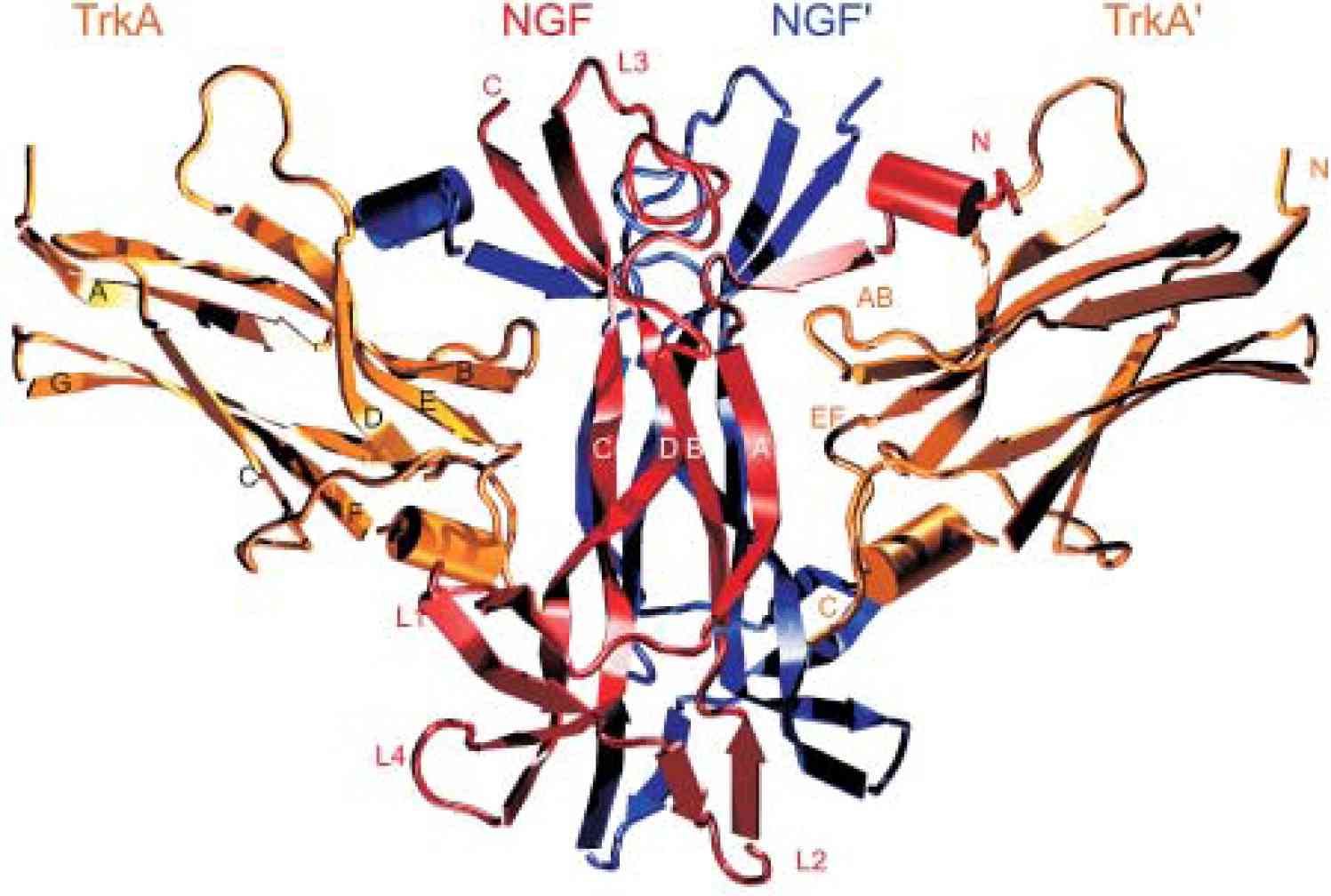What is NGF Protein
Nerve Growth Factor (NGF), an essential member of the neurotrophin family, plays a pivotal role in orchestrating the intricate dance of neuronal development and maintenance.
What is NGF Protein?
NGF, classified under the neurotrophin umbrella, stands as a trophic factor crucial for neuronal health. A small protein, NGF is encoded by the NGF gene and synthesized as a precursor, proNGF, which undergoes proteolytic cleavage to yield the mature, biologically active form. Structurally, NGF comprises 118 amino acids arranged in a characteristic beta-sheet-rich structure stabilized by disulfide bonds.

Figure 1. Three-dimensional structure of the complex formed by NGF homodimers and two TrkA domain 5. (Settanni, G., et al. 2003)
The Function of NGF Protein
NGF's biological prowess lies in its ability to bind with high affinity to its primary receptor, Tyrosine Kinase A (TrkA), expressed predominantly on the surface of neurons. This binding initiates a cascade of intracellular events, propelling cellular responses fundamental to neuronal survival, growth, and differentiation.
Promoting Neuronal Survival: NGF acts as a sentinel, thwarting apoptosis, or programmed cell death, in neurons during development. This pivotal function ensures the requisite neuronal population for the intricate neural circuitry that characterizes a functional nervous system.
Guiding Neuronal Growth and Differentiation: NGF serves as a molecular guidebook, influencing the growth and differentiation of neurons. This is exemplified in the regulation of axonal and dendritic processes, shaping the elaborate architecture of the nervous system.
NGF-Related Diseases
Imbalances in NGF levels or signaling pathways correlate with an array of neurological disorders, shedding light on the delicate equilibrium required for neuronal homeostasis.
- Alzheimer's Disease
In the context of Alzheimer's, reduced NGF levels in the brain have been observed. This deficiency is implicated in the neurodegeneration characteristic of the disease, offering a potential avenue for therapeutic exploration.
- Peripheral Neuropathies
NGF's involvement in the maintenance of peripheral nerves links it to peripheral neuropathies, where disruptions in NGF signaling contribute to the damage of nerves transmitting signals between the central nervous system and the periphery.
- Pain Disorders
Elevated NGF levels are associated with chronic pain conditions, indicating a role in the modulation of pain sensitivity, a facet extensively explored for potential interventions.
NGF Related Signaling Pathways
Decoding the intricate signal pathways activated by NGF is imperative for unraveling its role in neuronal dynamics and its implications in diseases.
The binding of NGF to TrkA triggers phosphorylation events, instigating downstream signaling cascades. The Mitogen-Activated Protein Kinase (MAPK) pathway regulates gene expression, while the Phosphoinositide 3-Kinase (PI3K) pathway promotes cell survival, collectively shaping the fate of the neuron.
Applications of NGF in Biomedical Research
The profound influence of NGF on neuronal health positions it as a promising candidate for biomedical applications, where researchers strive to harness its potential for therapeutic interventions.
- Neurodegenerative Diseases
NGF, or NGF mimetics, emerges as a beacon of hope for neurodegenerative diseases. Strategies involving direct delivery of NGF to affected regions or the development of NGF-like compounds aim to mitigate the neurodegenerative cascade observed in diseases like Alzheimer's and Parkinson's.
- Peripheral Nerve Regeneration
NGF's role in peripheral nerve maintenance fuels research in leveraging NGF for regenerative purposes. Potential applications include promoting nerve regeneration after injuries, addressing a critical aspect of peripheral nerve disorders.
- Pain Management
Unraveling NGF's involvement in pain signaling pathways has spurred investigations into NGF-targeted therapies for chronic pain conditions. Modulating NGF levels or interfering with NGF signaling emerges as a prospective strategy for more effective pain management.
- Advanced Drug Delivery Systems
Challenges in delivering therapeutic proteins, including NGF, have led to the development of innovative drug delivery systems. Nanoparticles and other advanced delivery methods aim to enhance the targeted delivery of NGF, ensuring precision in therapeutic interventions.
Understanding the functions, signal pathways, and implications of NGF in diseases provides a foundation for developing targeted therapies and interventions that may revolutionize the field of neuroscience and improve the lives of individuals affected by neurological conditions. As research in this field progresses, the potential of NGF in reshaping the landscape of neurobiology and medicine remains a beacon of hope for the future.
Recommended Products for NGF Protein
| Cat.# | Species | Product name | Source (Host) | Tag |
|---|---|---|---|---|
| NGF-573H | Human | Active Recombinant Human Nerve Growth Factor (beta polypeptide) | E.coli | N/A |
| NGF-002H | Human | Active Recombinant Human NGF, MIgG2a Fc-tagged | CHO | Fc |
| NGF-05H | Human | Active Recombinant Human NGF protein | CHO | N/A |
| NGF-1287H | Human | Recombinant Human NGF, GST-tagged | E.coli | GST |
| NGF-425H | Human | Recombinant Human NGF protein, His-tagged | HEK293F | His |
| NGF-814H | Human | Recombinant Human NGF Protein, MYC/DDK-tagged | HEK293 | Myc/DDK |
| Ngf-477M | Mouse | Recombinant Mouse Ngf, None tagged | CHO | N/A |
| Ngf-4407M | Mouse | Recombinant Mouse Ngf Protein, Myc/DDK-tagged | HEK293T | Myc/DDK |
| Ngf-5481R | Rat | Recombinant Rat Ngf protein, His-tagged | Yeast | His |
| NGF-1153P | Pig | Recombinant Pig NGF Protein, His-tagged | E.coli | N-His |
Reference
- Settanni, G., et al. Molecular dynamics simulations of the NGF-TrkA domain 5 complex and comparison with biological data. Biophys J. 2003, 84(4): 2282-2292.

